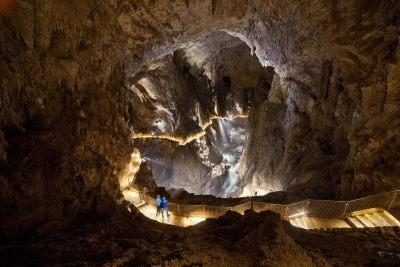
Skocjan Caves Regional Park is situated in the Kras Plateau of South-West Slovenia. The protected area of 413 ha conserves an exceptional limestone cave system which comprises one of the world’s largest known underground river canyons, that was cut into the limestone bedrock by the Reka River. Along its course, the river suddenly disappears into the karst underground, before passing through a vast and picturesque channel of up to 150 meters in height and more than 120 meters in width, often in the form of dramatically roaring rapids and waterfalls. The canyon’s most spectacular physical expression is the enormous Martel Chamber, which exceeds two million cubic meters in volume. Like the canyon, the vast underground halls and chambers of the cave system expose stunning variations of limestone bedrock and secondary cave formations. It is no coincidence that karst research has its origin in this very part of Slovenia, which is scientifically referred to as “Classical Karst”. The term “karst” itself is derived from the name of the plateau, and is one of many technical terms commonly used in geology and speleology that have their origin in the region. Beyond its almost supernatural visual appeal, its scale and scientific importance, the regional park is also home to noteworthy species and species assemblages, which thrive in the distinct world of the underground environment and in the so-called collapsed dolines, a form of karst sinkholes. The caves support many endemic and endangered species, including the Cave Salamander along with many invertebrates and crustaceans. The very particular environmental conditions of the collapsed dolines provide a habitat for rare and threatened flora and fauna. Furthermore, ongoing archaeological studies have been revealing ever more details of a very long history of human occupation since prehistoric times. There is strong evidence that our ancestors appreciated the area as a place for settlements. Archaeological research has also disclosed that the area was historically used as a burial ground as well as for rituals.
The Skocjan cave system and its surroundings are eminent and well-conserved manifestations of Karst topography. It reveals a broad range of karst features with its exceptional scale and aesthetic quality. Some outstanding landscape highlights include the vast, roughly two-kilometre long underground canyon, up to some 150 metres high and in places more than 120 metres wide. An underground torrent runs through it along series of cascades, turning it into a major visual and auditory spectacle. Higher up in the drier ceilings and walls of the canyon, limestone deposition from dripping water has been shaping astonishing stalagmites and stalactites, such as the so-called Giants in Velika Dvorana (or “Great Chamber”). The magnificent rimstone pools in Dvorana Ponvic (or “Chamber of Rimstone Pools”) are equally impressive manifestations of calcite deposits. The famous pools have been attracting scientists and artists ever since their formal discovery in 1888, and their representations came to epitomize the otherworldly beauty of the Skocjan Caves. The main channel of the celebrated underground river resurfaces in two picturesque collapsed dolines named Velika and Mala. The breath-taking view of these two collapsed dolines is depicted in the drawings of the pioneering explorer Valvasor that date back as early as 1689, and has never ceased to fascinate visitors, artists and scientists.
Credit : UNESCO
Picture Credit : Google




